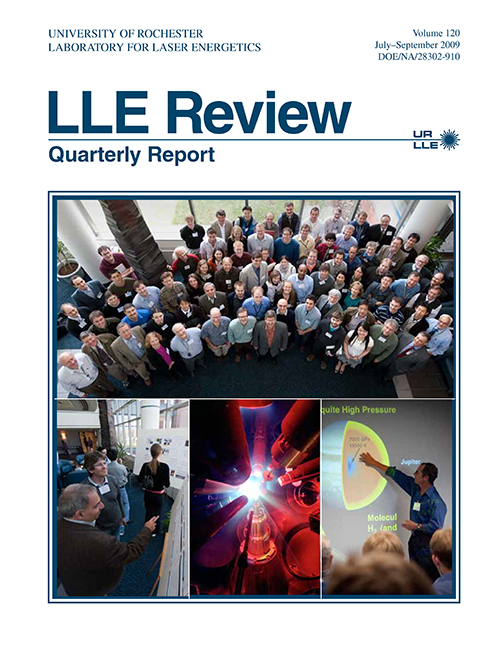LLE Review 120
Highlights
This volume of the LLE Review, covering July–September 2009, features a summary and report on the first Omega Laser Facility Users Group (OLUG) Workshop organized by the OLUG Executive Committee. More than 100 researchers from 29 universities and laboratories and 4 countries gathered at the Laboratory for Laser Energetics (LLE) from 29 April–1 May 2009 for the three-day workshop to facilitate undertaken at the Omega Facility and in a complementary fashion at other facilities (such as LULI or the NIF); and to provide feedback to LLE from the users about ways to improve the facility and future experimental campaigns. Six overview science talks described the breadth and excitement of high-energy-density (HED) science undertaken on OMEGA, both present and future. The final overview talk concerned the role and importance of science to the National Nuclear Security Administration (NNSA) mission. Thirty-two students and postdoctoral fellows attended the workshop and presented 31 of the 48 contributed poster and oral presentations. The presentations ranged from target fabrication to simulating important aspects of supernovae. An important function of the workshop was to develop a set of recommendations and findings to guide future priorities for OMEGA. The original report and management’s response are are included in the article.
Additional highlights of research presented in this issue include the following:
- The effect of condensates and inner coatings on the performance of vacuum hohlraum targets are described. Experiments on the OMEGA Laser System using laser-driven vacuum hohlraum targets show distinct differences between cryogenic (<20 K) and warm targets. Warm hohlraum targets coated with 2 mm of CH replicate the behavior of cryogenic targets indicating that cryogenic hohlraums are affected by the condensation of background gases on the cold hohlraum surface. The coatings (both CH and condensates) produce long-scale-length, low-Z plasmas that reduce the absorption of laser light in the hohlraums. This causes higher reflectivity and produces hot electrons that generate hard x rays (h > 20 keV), both of which are detrimental to the performance of hohlraum-driven inertial confinement fusion targets.
- Magnetorheological finishing (MRF) spotting experiments performed on glasses and ceramics using a zirconia-coated-carbonyl-iron-particle–based magnetorheological (MR) fluid are reported. Coated particles showed long-term stability against aqueous corrosion. Spot-polishing tests were performed on a variety of optical glasses and ceramics over a period of nearly three weeks with no signs of MR fluid degradation or corrosion. Stable material-removal rates and smooth surfaces inside spots were obtained.
- An all-fiber optical magnetic field sensor was demonstrated. It consists of a fiber Faraday rotator and a fiber polarizer. The all-fiber optical magnetic field sensor has a sensitivity of 0.45 rad/T and can measure a magnetic field up to 3.5 T.
- Experimental studies on the time-resolved carrier dynamics in high-quality Al0.86Ga0.14N single crystals, grown using a solution technique in a high-nitrogen-gas-pressure system are reported. Optical measurements were performed using two-color, femtosecond pump–probe spectroscopy. The two-photon-absorption coefficient was measured, as well as its spectral dependence, and confirmed that within the tuning range of the laser, the latter was in very good agreement with the Sheik–Bahae theory for wide, direct-bandgap semiconductors.
- This volume also includes a summary of LLE’s Summer High School Research Program, the FY09 Laser Facility Report, and a report on the National Laser Users’ Facility and External Users’ Programs.
- The Omega Laser Facility Users Group Workshop 29 April – 1 May 2009
- The Effect of Condensates and Inner Coatings on the Performance of Vacuum Hohlraum Targets
- Zirconia-Coated-Carbonyl-Iron-Particle–Based Magnetorheological Fluid for Polishing Optical Glasses and Ceramics
- All-Fiber Optical Magnetic Field Sensor Based on Faraday Rotation in Highly Terbium Doped Fiber
- Femtosecond Optical Pump–Probe Characterization of High-Pressure–Grown Al0.86Ga0.14N Single Crystals
- LLE’s Summer High School Research Program
- FY09 Laser Facility Report
- National Laser Users’ Facility and External Users’ Programs
- Publications and Conference Presentations

